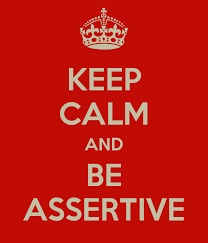Feeling assertive? No? Well you’re not alone. On our Essential Assertiveness course we often hear the same thing from delegates. Reasons range from not wanting to hurt others to fear of being perceived as a tad machiavellian. If you can answer yes to the following questions, you may benefit from flexing your assertiveness muscles:
Do you worry about hurting others’ feelings if you’re assertive?
Is the path of least resistance your favourite route?
Are you afraid of being thought of as a bully?
Do you feel that there’s something not quite ‘nice’ about being assertive?
Are you afraid you’ll be disliked if you disagree?
Do you find it hard to say ‘No’
Are you constantly putting others first and yourself last?
Are you frustrated when you don’t speak up?
Feel you owe more to yourself than keeping quiet?
If you answered yes, there’s a good chance you need to keep calm, carry on and put the following tips into practice.
Step 1: Examine Your Beliefs About Assertiveness:
It’s time to make like Inspector Clouseau and work out where those beliefs about assertiveness come from. And then ask yourself if they’re really true. The next time you stop yourself from speaking up for any of the reasons outlined above. Stop. Pause and ask yourself;
Where’s the evidence? Am I 100% sure it’s true?
Look for alternatives. For example, before you say yes instead of no because you think others will think you’re being difficult, examine your thinking. Find an alternative response, a more effective way of thinking:
‘The other person will understand that I’m busy right now.” or “Other people say no and nobody minds. It’s ok for me too.”
Once you begin to question your thinking you’ll find that very few of our beliefs about ‘how things are’ in life are true. Other than we’re born, we die and we get taxed in between we can’t think of anything else that isn’t up for discussion!
Step 2: Prepare, prepare, prepare
Planning and preparation will stand you in good stead for those moments of amygdala hijack when your mind goes blank (it happens to the best of us). Try using a simple script to help you get your point across in difficult conversations. We love this easy, peasey example:
“When you…….” State clearly what happened.
“I feel…..” Let the other person know the impact of whatever has happened upon you using objective, neutral language.
“What would really help me is….” State what you would like them to do.
“How does that sound?” Check in with the other person to see if they’re on the same page.
Having a plan will stop you searching for words, ‘umming’ ‘erring’ and wondering how you’re going to get your view across.
Step 3: Give Yourself Permission & Believe You Can:
Self belief is the cornerstone of assertiveness. Work on your thinking, identify your beliefs (see step 1) and then commit to being assertive. Start practicing right now. Set yourself small assertiveness goals each day. Make a pact with yourself to communicate your opinions, feelings, beliefs and wants on a daily basis. Give yourself the rights and responsibilities associated with assertiveness. The right to express opinions and to say no along with the responsibility to do it. Permission granted. Knock the guilt (and the fear) on the head and go for it. The more you achieve your assertiveness goals the more you’ll build your assertiveness muscles and believe that you can.
Want to find out more? Check out our free resources!

